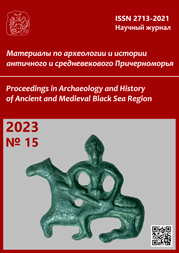Декоративно отделанные надмогильные стелы женских погребений XIV—XVI вв. из Кубачи
Decoratively finished grave stelae of female burials of the 14th — 16th century from Kubachi
Author(s): M.M. MammaevSubject(s): History, Archaeology, Cultural history, 13th to 14th Centuries, 15th Century, 16th Century
Published by: Нижневартовский государственный университет
Keywords: Dagestan; Kubachi; Late Mediaeval period; Islam; burial rite; female graves; burial stelae; stone carving; epigraphy;
Summary/Abstract: Ten decorated female grave stelae of the 14th — 16th century from Kubachi are published and discussed here as a newly recovered sample of stone carving, Arabic epigraphy and calligraphy. Stelae were identified by the author in the end of 1990s and the beginning of 2000s at the medieval Muslim cemeteries “Bidah khuppe” (which means “Graves on the Other Side” in Kubachi language), “Tsitsila 2” and “Tsitsila 3”. These cemeteries are located 1.5—2 km south of the old part of Kubachi, in the lower half of the mountain slope of Tsitsila. Some carved gravestones of the 14th — 16th centuries have already been studied by the author and other researchers, while many artistically decorated monuments, including stelae placed on the female burials, still remain unexplored. Stelae are vertically mounted stone slabs of elongated quadrangular or trapezoid shape; some stelae, which date back to the 16th century and later on, have had lancet-like tops with figured edges. Medieval female tombstones are considered in comparative terms along with decorated stelae of male and children's graves published elsewhere by the author. Their chronology is based on the paleographic features of Arabic inscriptions and the style of floral decoration images. Decorated female grave stelae may shed a new light on some issues of the place and role of a woman in medieval Muslim society of Zirikhgeran-Kubachi.
Journal: Материалы по археологии и истории античного и средневекового Причерноморья
- Issue Year: 2023
- Issue No: 15
- Page Range: 944-968
- Page Count: 25
- Language: Russian

